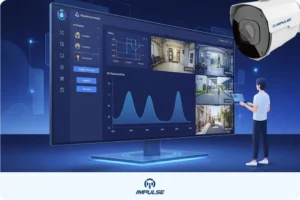The Debate Is Still On In Global Markets – Analog CCTV VS IP

Analog cameras still dominate emerging markets due to their cheaper costs and ease of installation. Analog cameras are usually categorised based on the number of TVL (TV Lines) – example: 540, 600, 800TVL and occasionally 960H with the higher the number generally being the better choice. With the higher number being better you are ultimately limited to a maximum pixel count of 960×480 (960H) which is not HD by any means. Analog DVRs and cameras are mostly interchangeable meaning you can mix and match cameras and DVRs from different manufacturers without any configuration headaches. The analog camera is a dumb camera, has no intelligence and no post processing. However, this easy setup comes with some serious drawbacks. Low limited resolutions provide a poor image which can often be pixelated and grainy. A maximum resolution of 960H is the highest possible or 960×480 to be exact. Think of a high definition 1080p TV with a resolution of 1920×1080, when comparing the two, 960H provides much less detail and quality. This often results in less incident identifications due to specific features not being distinguishable on captured video. Nevertheless, this technology is still available for a low price from most vendors. The analog world got a fresh lease of life via the HDCVI technology. This technology allows HD quality over co-ax cable upto 500 feet with no RS-485 (seperate cable runs) for PTZ. The max resolution for HDCVI is 2 megapixel. HDCVI cameras drop off the map where IP cameras are easily accessible and readily available up to 29 megapixels. HDCVI is still relatively new in the scheme of things so we’d like to give it the benefit of the doubt; whether or not 2 megapixels will be a limitation of this technology is still up for debate.
HDCVI and non-PoE IP cameras will require either an individual power supply, or power distribution box. You will use either use DC power terminals to attach your DC cable to the cameras individual power supply, or you will directly attach your DC cable to the screw down terminals in your power distribution box if you have one. IP Cameras with PoE capability will be powered via your single length of Cat5e/Cat6 cable by a PoE network switch. While providing power to your cameras, the network switch will also serve to connect your cameras to your network. Both camera types, HDCVI and IP, are capable of recording to standalone video recorders. HDCVI is paired with the HDCVI DVR, while IP is paired with the NVR. The DVR and NVR are virtually the same thing as far as build and features are concerned. The difference between them is how your cameras may connect to them.With an HDCVI system, your coaxial cable will be hardwired right to the back of the DVR. IP camera systems can mimic this setup, but only if the NVR possesses PoE ports on the back of it. The alternative it to connect all of your cameras and NVR to a network switch before connecting it to your network (router/modem). At this point, your cameras and NVR will be on the same network, but your cameras will now have to be manually added to the NVR using the graphic user interface (GUI). This will also mean needing to use the IP configuration tool to pre-configure each IP camera.
We know this is where we’re ending, but for most of us, this is where we start. The simple fact is that even though IP cameras have been dropping in cost considerably, HDCVI cameras are still cheaper. This is a pretty heated issue to discuss among professionals, but like we said, fair is fair. Not only are the cameras cheaper, but HDCVI DVRs are also cheaper than the NVRs needed for IP cameras, although not as noticeably this time. You may find yourself saving a hundred dollars per camera by switching to HDCVI but only saving about a hundred dollars total when you reach your most expensive items; video recorders. Cables and connectors are where IP cameras redeem themselves. Cat6 cable is easily less than half the cost of solid copper RG59 cable.
The trend in Home / Small office surveillance is clearly towards Analog. Most Government, Large Commercial and Industrial projects prefer IP systems due to the flexibility, software analytic options and “future readiness” of systems.
HDCVI and non-PoE IP cameras will require either an individual power supply, or power distribution box. You will use either use DC power terminals to attach your DC cable to the cameras individual power supply, or you will directly attach your DC cable to the screw down terminals in your power distribution box if you have one. IP Cameras with PoE capability will be powered via your single length of Cat5e/Cat6 cable by a PoE network switch. While providing power to your cameras, the network switch will also serve to connect your cameras to your network. Both camera types, HDCVI and IP, are capable of recording to standalone video recorders. HDCVI is paired with the HDCVI DVR, while IP is paired with the NVR. The DVR and NVR are virtually the same thing as far as build and features are concerned. The difference between them is how your cameras may connect to them.With an HDCVI system, your coaxial cable will be hardwired right to the back of the DVR. IP camera systems can mimic this setup, but only if the NVR possesses PoE ports on the back of it. The alternative it to connect all of your cameras and NVR to a network switch before connecting it to your network (router/modem). At this point, your cameras and NVR will be on the same network, but your cameras will now have to be manually added to the NVR using the graphic user interface (GUI). This will also mean needing to use the IP configuration tool to pre-configure each IP camera.
We know this is where we’re ending, but for most of us, this is where we start. The simple fact is that even though IP cameras have been dropping in cost considerably, HDCVI cameras are still cheaper. This is a pretty heated issue to discuss among professionals, but like we said, fair is fair. Not only are the cameras cheaper, but HDCVI DVRs are also cheaper than the NVRs needed for IP cameras, although not as noticeably this time. You may find yourself saving a hundred dollars per camera by switching to HDCVI but only saving about a hundred dollars total when you reach your most expensive items; video recorders. Cables and connectors are where IP cameras redeem themselves. Cat6 cable is easily less than half the cost of solid copper RG59 cable.
The trend in Home / Small office surveillance is clearly towards Analog. Most Government, Large Commercial and Industrial projects prefer IP systems due to the flexibility, software analytic options and “future readiness” of systems.



